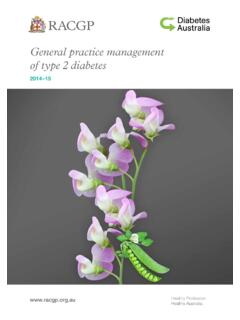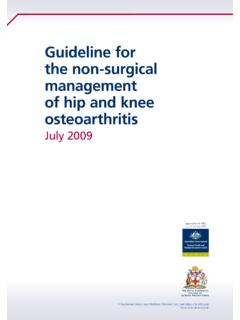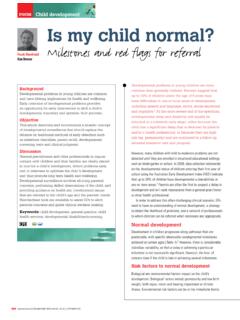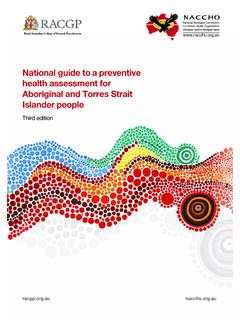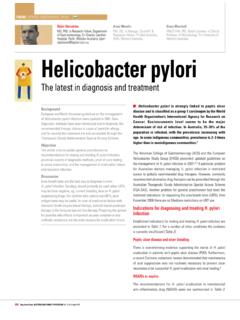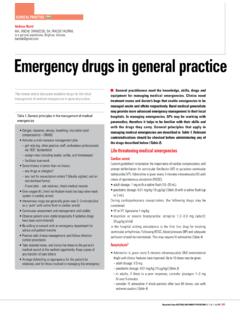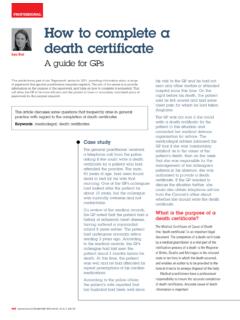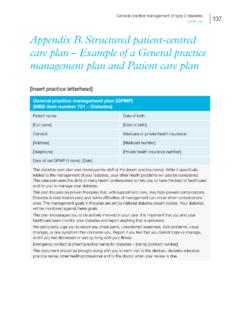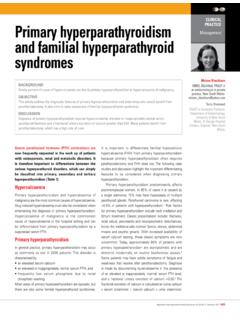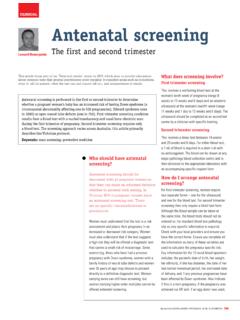Transcription of Guideline for the management of knee and hip osteoarthritis
1 For the management of knee and hip osteoarthritis Second editionGuideline for the management of knee and hip osteoarthritis . Second editionDisclaimerThe information set out in this publication is current at the date of first publication and is intended for use as a guide of a general nature only and may or may not be relevant to particular patients or circumstances. Nor is this publication exhaustive of the subject matter. Persons implementing any recommendations contained in this publication must exercise their own independent skill or judgement or seek appropriate professional advice relevant to their own particular circumstances when so doing. Compliance with any recommendations cannot of itself guarantee discharge of the duty of care owed to patients and others coming into contact with the health professional and the premises from which the health professional the text is directed to health professionals possessing appropriate qualifications and skills in ascertaining and discharging their professional (including legal) duties, it is not to be regarded as clinical advice and, in particular, is no substitute for a full examination and consideration of medical history in reaching a diagnosis and treatment based on accepted clinical , The Royal Australian College of General Practitioners Ltd (RACGP) and its employees and agents shall have no liability (including without limitation liability by reason of negligence)
2 To any users of the information contained in this publication for any loss or damage (consequential or otherwise), cost or expense incurred or arising by reason of any person using or relying on the information contained in this publication and whether caused by reason of any error, negligent act, omission or misrepresentation in the citationThe Royal Australian College of General Practitioners. Guideline for the management of knee and hip osteoarthritis . 2nd edn. East Melbourne, Vic: RACGP, Royal Australian College of General Practitioners Ltd 100 Wellington Parade East Melbourne, Victoria 3002 Tel 03 8699 0414 Fax 03 8699 0400 : 34 000 223 807 ISBN: 978-0-86906-500-6 First edition (Guidelines for the non-surgical management of hip and knee osteoarthritis ) published 2009 Second edition published July 2018 The Royal Australian College of General Practitioners 2018 This resource is provided under licence by the RACGP.
3 Full terms are available at In summary, you must not edit or adapt it or use it for any commercial purposes. You must acknowledge the RACGP as the acknowledge the Traditional Custodians of the lands and seas on which we work and live, and pay our respects to Elders, past, present and ApprovalThe Guideline recommendations on pages 5 12 of this document were approved by the Chief Executive Officer of the National Health and Medical Research Council (NHMRC) on 9 July 2018 under section 14A of the National Health and Medical Research Council Act 1992. In approving the Guideline recommendations, NHMRC considers that they meet the NHMRC standard for clinical practice guidelines. This approval is valid for a period of five is satisfied that the Guideline recommendations are systematically derived, based on the identification and synthesis of the best available scientific evidence, and developed for health professionals practising in an Australian healthcare publication reflects the views of the authors and not necessarily the views of the Australian for the management of knee and hip osteoarthritis Second editioniiiGuideline for the management of knee and hip osteoarthritisSecond editionAbout this guidelineThe Royal Australian College of General Practitioners (RACGP) first developed Guidelines for the non-surgical management of hip and knee osteoarthritis in 2009.
4 Since then, there has been substantial progress in evaluating the effectiveness and safety of commonly used and new therapies for osteoarthritis (OA). The objective of this new Guideline is to present the best available, current scientific evidence for OA interventions, covering all interventions other than joint replacement for the hip and population and audience This Guideline applies to all adults diagnosed with symptomatic OA of the hip and/or knee up until referral for joint replacement. While this Guideline is intended primarily for use in the primary care setting by general practitioners (GPs), consideration of the relevance of this Guideline was also given to other health professionals who treat people with OA. This is reflected in the multidisciplinary composition of the Guideline development working group, including consumer for the management of knee and hip osteoarthritisSecond editionAcronyms ACR American College of RheumatologyAIHW Australian Institute of Health and WelfareASU avocado/soybean unsaponifiablesBMI body mass indexCALD culturally and linguistically diverseCBT cognitive behavioural therapyCENTRAL Cochrane Database of Systematic Reviews and Cochrane Central Register of Controlled TrialsCI confidence intervalCINAHL Cumulative Index to Nursing and Allied Health LiteratureCOI conflict of interestCOX cyclooxygenaseCOX-2 cyclooxygenase-2 CRP C-reactive proteinCT computed tomographyDALYs disability-adjusted life-yearsDHA docosahexaenoic acidDMOADs disease-modifying osteoarthritis drugsDMSO dimethylsulfoxideEMA European Medicines AgencyEPA eicosapentaenoic acidESR erythrocyte sedimentation rateFGF fibroblast growth factorGP general practitionerGRADE Grading of Recommendations
5 Assessment, Development and EvaluationHANDI Handbook of non-drug interventionsHOOS Hip Disability and osteoarthritis Outcome ScoreICTRP International Clinical Trials Registry PlatformIgG2 immunoglobulin G2IL-1 interleukin-1 IPDAS International Patient Decision Aids StandardsKOOS Knee Injury and osteoarthritis Outcome ScoreMBS Medicare Benefits ScheduleMD mean differenceMRI magnetic resonance imagingMSC mesenchymal stem cellMSM methylsulfonylmethaneNATSIHS National Aboriginal and Torres Strait Islander Health SurveyNGF nerve growth factorNHMRC National Health and Medical Research CouncilNICE National Institute for Health and Care ExcellenceNPRS Numeric Pain Rating ScaleNSAID nonsteroidal anti-inflammatory drugOA osteoarthritisOARSI osteoarthritis Research Society InternationalOR odds ratiop75 NTR 75 kDa neurotrophin receptorPBS Pharmaceutical Benefits SchemePG prostaglandinPHN Primary
6 Health NetworkPICO patient/population/problem, intervention, comparison/control, outcomePPI proton-pump inhibitorPRAC Pharmacovigilance Risk Assessment CommitteePRP platelet-rich plasmaRACGP The Royal Australian College of General PractitionersRCT randomised controlled trialRR relative riskSES socioeconomic statusSMD standardised mean differenceSNRI serotonin and norepinephrine reuptake inhibitorTEAE treatment-emergent adverse eventTENS transcutaneous electrical nerve stimulationTGA Therapeutic Goods AdministrationTNF-alpha tumour necrosis factor alphaTrkA tyrosine kinase receptorTRPV1 Transient Receptor Potential Vanilloid 1 VAS Visual Analog ScaleWHO World Health OrganizationWOMAC Western Ontario and McMaster Universities osteoarthritis IndexvGuideline for the management of knee and hip osteoarthritisSecond editionAcknowledgementsThe update of the Guideline for the management of knee and hip osteoarthritis was supported by The Royal Australian College
7 Of General Practitioners (RACGP) and Medibank Better Health Foundation. The RACGP gratefully acknowledges the generous contribution of the working group members in the development of this development working group members Professor David Hunter, co-Chair, Guideline development working group; Florance and Cope Chair, Institute of Bone and Joint Research, Kolling Institute, University of Sydney, New South Wales; Rheumatologist, Royal North Shore Hospital, New South WalesProfessor Kim Bennell, co-Chair, Guideline development working group; Director, Centre for Health, Exercise and Sports Medicine, Department of Physiotherapy, University of Melbourne, VictoriaProfessor Michael Austin, Associate Dean, School of Engineering, RMIT University, VictoriaProfessor Andrew Briggs, School of Physiotherapy and Exercise Science, Faculty of Health Sciences, Curtin University, Western AustraliaProfessor Rachelle Buchbinder, Director, Monash Department of Clinical Epidemiology, Cabrini Hospital, Victoria; Professor, Department of Epidemiology and Preventive Medicine, Monash University, VictoriaDr Stephen Bunker, Clinical Research Advisor, Medibank Private LtdProfessor Peter Choong, Chair of surgery and Head of Department of surgery , University of Melbourne, St Vincent s Hospital Melbourne, Victoria; Director of Orthopaedics, St Vincent s Hospital Melbourne, Victoria.
8 Chair, Bone and Soft Tissue Sarcoma Service, Peter MacCallum Cancer CentreDr Dan Ewald, general practitioner, Lennox Head Medical Centre, New South Wales; Bullinah Aboriginal Health Service, Ballina, New South Wales; Adjunct Associate Professor, University of Sydney and Northern River University Centre for Rural Health, New South Wales; Lead clinical advisor, North Coast NSW PHNP rofessor Kieran Fallon, Professor of Sport and Exercise Medicine and Sport and Exercise Medicine Physician, Department of Rheumatology, Canberra Hospital, Australian National University, Canberra, ACTMr Ben Harris (November 2016 June 2017), General Manager, Policy, Information and Programs, MOVE muscle, bone & joint healthProfessor Rana Hinman, Australian Research Council Future Fellow, Centre for Health, Exercise and Sports Medicine, Department of Physiotherapy, University of Melbourne, VictoriaDr Leonie Katekar, Clinical Director, Medibank Private LtdAssociate Professor Marie Pirotta, general practitioner.
9 Department of General Practice, University of Melbourne, VictoriaDr Michael Ponsford, rehabilitation medicine specialist, Epworth Hospital, VictoriaAssociate Professor Morton Rawlin, general practitioner, Macedon Medical Centre, VictoriaDr Xia Wang, epidemiologist, University of Sydney, New South WalesDr Samuel Whittle, Senior consultant rheumatologist, Queen Elizabeth Hospital, Woodville South, South AustraliaEvidence consultantsDr Raveendhara R Bannuru, Director, Center for Treatment Comparison and Integrative Analysis; Deputy Director, Center for Complementary and Integrative Medicine; Assistant Professor of Medicine, Division of Rheumatology, Tufts Medical Center and Tufts University School of Medicine, Boston, MA, USAMs Mikala Osani, Project Coordinator, Center for Treatment Comparison and Integrative Analysis, Tufts Medical Center, Boston, MA, USAviGuideline for the management of knee and hip osteoarthritisSecond editionConflicts of interest This Guideline was produced in accordance with the rules and processes outlined in the RACGP Conflict of Interest Policy.
10 The RACGP Conflict of Interest Policy is available at of interest (COI) disclosures are available in the Guideline for the management of knee and hip osteoarthritis : Administrative Guideline development working group members completed a COI register before the commencement of Guideline development. Any additional COIs were declared at the start of all meetings, and appropriately recorded. If a member declared a COI relating to a specific intervention (except researching), they did not participate in the discussion or decision-making for the development of the Guideline for the management of knee and hip osteoarthritis is funded in part by Medibank Better Health Foundation. It provided support for the development of systematic literature reviews, data extraction and compilation of the Grading of Recommendations Assessment, Development and Evaluation (GRADE) summary review of this Guideline This Guideline will be reviewed no less than once every five for the management of knee and hip osteoarthritisSecond editionContentsAbout this Guideline iiiTarget population and audience iiiAcronyms ivAcknowledgements vGuideline development working group members vConflicts of interest viFuture review of this Guideline viSummary.
